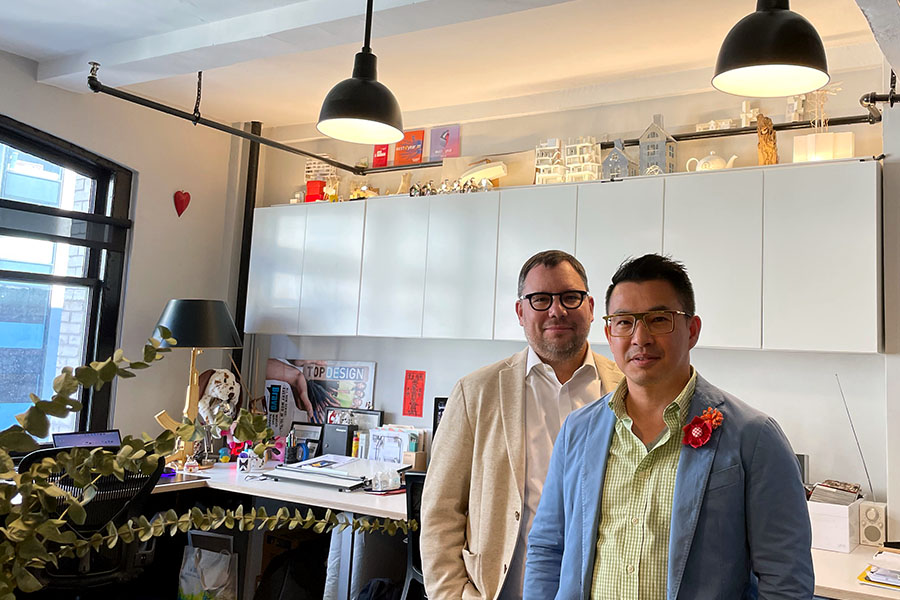School of Architecture
Home Away From Home
written by
Pamela Wigley
Growing up one of four children in Bangkok, Thailand, Goil Amornvivat left the comforts of home to attend middle and high school in Massachusetts. His mother, who encouraged her children’s independence, furthered his future when she sent him to Paris for the summer at age 16. He enjoyed his time there, but didn’t find his second home until he arrived in Pittsburgh to attend Carnegie Mellon University’s School of Architecture.
With an older brother already ensconced in engineering studies at CMU, it could have been that familial bond that helped Amornvivat feel the connection. Instead, he said, “it was the care and tutelage of his professors and the city itself that provided direction.”
“Pittsburgh is a remarkable place for young architects. The lessons are written in steel and stone — even through the College of Fine Arts building, whose architect, Hornbostel, designed the building as a learning tool for young architects.”
Goil Amornvivat
Amornvivat found inspiration in Doug Cooper, Andrew Mellon Professor of Architecture, whom Amornvivat still recalls getting down to the students’ level to teach them how to observe, understand and draw the environment.
“He was there beside us as we used the city as our laboratory to learn,” Amornvivat said. “He was hands-on, patient and kind. He knew everything there was to know about his subject. Doug, Pittsburgh and Carnegie are all exceptional; they are the gold standard in architecture education. And, at a time when I needed to feel a connection, I found it.”

The combination of nurturing and learning put Amornvivat on the path to big things. He earned his bachelor’s from CMU in 1996 and went on to Yale University to earn his master’s degree. There, he met Tom Morbitzer, now Amornvivat’s life and business partner at AMMOR Architecture llp. Morbitzer has witnessed firsthand the influence that Carnegie’s School of Architecture had on Amornvivat.
“He talks about his time there frequently. His teachers not only taught him architecture, but also how to teach architecture — how to be nimble. Goil makes everything he touches better.”
Tom Morbitzer
Being nimble in a business that’s always changing is a definite plus. At the core of their work, though, is one simple component that has always worked to their benefit: Listening.
“You have to listen [to your clients] in so many different ways,” Amornvivat said. “Vivian Loftness started her deanship with a ‘listening tour.’ To us, as students and young adults, it was refreshing, a different kind of leadership. It said all the right things to impressionable minds.”
Learning to listen, he said, helped him achieve other notable milestones in his career. He was on Bravo television’s “Top Design,” served as a designer on TLC’s “Trading Spaces” and was the winner of HGTV’s White Room Challenge. From his winnings on the latter, Amornvivat donated the winnings to a soup kitchen in his Brooklyn neighborhood.
“A rising tide lifts all ships, and I wanted my TV experiences to be meaningful and to help others,” he said. The exposure earned him and Tom some great clients, including Whoopi Goldberg, who has the team at AMMOR design her annual holiday ornament, among other projects – such as designing her offices and her game show set. Their hard work, though, is what keeps the firm chugging.

“We have a mid-western ‘can-do’ attitude,” Amornvivat said. “We take each challenge one step at a time. As Doug Cooper taught me, a drawing starts with just one line. We’re down-to-earth people; we call it ‘relatable creativity.’”
He finds himself referring to other tenets he learned while a student at CMU, ones that he uses nearly every day in his work. First, the aforementioned ‘can-do’ attitude, instilled by the teachers he had at the school: Steve Lee, Bruce Lindsey, Stephanie Bartos and Scott Smith. Next, a belief that you must follow a lifelong path of curiosity and learning. Third, Amornvivat said that CMU instilled him with a sense of ‘responsibility,’ which is to say the ‘ability’ and passion to ‘respond’. “It’s more than the brick. We want what we make to be thoughtful and have meaning.”
Having a partner who shares his philosophies helps, too. On working with Morbitzer, Amornvivat said that compatibility plays into everything they do. “To every pot, you need the right lid. We trust each other. Tom sees the best. This optimism is a uniquely American perspective to everything.”
When giving advice to current students and young architects, Amornvivat encourages them to “connect the dots, look at challenges and see opportunities. Be present, open and available. Take risks. And always, be a good, ethical person, even if it doesn’t pay off right away.”
Successful architects, Morbitzer added, are those who can imagine something that doesn’t yet exist, helping to resolve a concern or meet a need.
Amornvivat concurred. “Architecture, education and practice can truly engage the world.”
